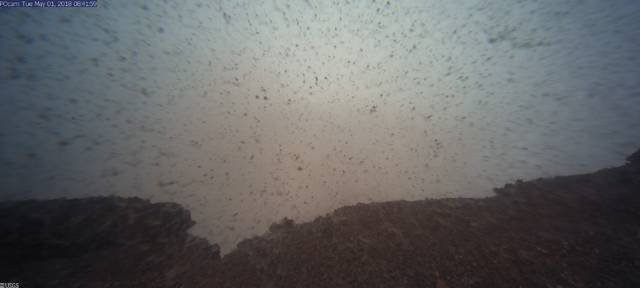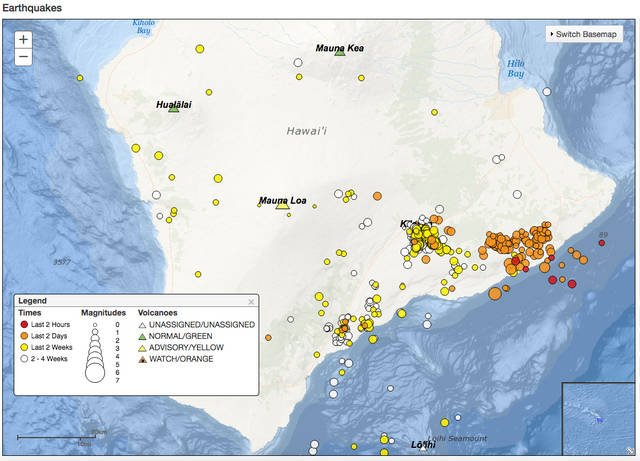KAILUA-KONA — Hawaiian Volcano Observatory scientists say they have found no evidence of steaming or ground cracks on the lower East Rift Zone Tuesday morning following increased earthquake activity in the wake of a collapse of the Puʻu ʻOʻo crater floor Monday afternoon.
Earthquake activity has tapered off Tuesday morning, said Janet Babb, Hawaiian Volcano Observatory spokeswoman. Deformation, which indicates movement of magma, is also on the decline.
“Right now, things have slowed down,” she said. “What we don’t know is if the event is over or if it’s merely a pause in the migration downrift.”
The activity follows the collapse of the Puʻu ʻOʻo crater floor Monday afternoon on Kilauea Volcano’s East Rift Zone following several weeks of increased activity there. The collapse prompted increases in seismicity and deformation along a large section of the rift zone indicating magma had intruded the rift zone.
Earthquakes, including a magnitude-4.0, were occurring as far east as Highway 130 in Puna.
A breakout of lava in a new location remains one possible outcome, scientists with the U.S. Geological Survey’s Hawaiian Volcano Observatory said Tuesday morning.
At this time, it is not possible to say with certainty if or where such an outbreak may occur, but the area downrift (east) of Puʻu ʻOʻo is the most likely location, because that is where seismicity and deformation had been concentrated overnight.
Residents of lower Puna should remain alert and watch for further information about the status of the volcano, Hawaii County Civil Defense said noting the agency is also monitoring the situation. Civil Defense messages are aired on radio stations and are posted online at www.hawaiicounty.gov/active-alerts.
Civil Defense also noted that the county Department of Parks and Recreation has shutdown the lava viewing area in Kalapana because of its proximity to the increased hazardous activity.
Poor weather has for the most part hampered HVO from flying over the activity or seeing details of the activity via HVO web cameras. However, Babb said a helicopter crew was able to survey the lower East Rift Zone Tuesday morning in Puna and found no evidence of steam or ground cracks.
The helicopter crew is currently waiting a break in the weather so scientists can check out what’s happening closer to Puʻu ʻOʻo, Babb said. Gound crews were headed into the area Tuesday morning with plans to install additional instruments to monitor the activity.
Without the ability to see the activity thus far, HVO is using instruments to measure seismicity and deformation to track the magma’s migration.
“Even with the poor weather conditions, instrumentally, we can track it,” said Babb.
Kilauea’s summit eruption has thus far not been affected by the change at Pu’u ‘O’o, according to the observatory.
“The summit lava lake remains at a high level,” the observatory said in its daily update. “Overall, the summit lava lake has shown no response to activity in the middle and lower East Rift Zone.”


